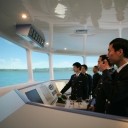American Culture
The US claims to be the greatest success story of the modern world - a nation fashioned from an incredibly disparate population who, with little in common apart from a desire to choose their own paths to wealth or heaven, rallied around the ennobling ideals of the Constitution and the Declaration of Independence to forge the richest, most inventive and most powerful country on earth.
Despite polemicists who justly cite the destruction of Native American cultures, racism and imperialism at the top of a long list of wrongdoings, half the world remains in love with the idea of America. This is, after all, the country that introduced the world to the right to the pursuit of happiness, free speech, electric light, airplanes, assembly-line automobiles, the space shuttle, computers, blues, jazz, rock & roll and movies that climax at the high-school prom.
On a short trip, it can be hard work dismantling your preconceptions. So much of the country has been filmed, photographed, painted and written about that you need to peel back layers of representation to stop it from looking like a stage setting. This worldwide representation can make the country seem strangely familiar when you first encounter novelties like 24-hour shopping, bottomless cups of coffee, 'Have a nice day,' drive-thru banks, TV evangelists, cheap gasoline and newspapers tossed onto lawns. But you'd be foolish to read too much into this su***ce familiarity, since you only have to watch Oprah for half an hour to realize that the rituals and currents of American life are as complex, seductive and bewildering as the most alien of cultures.
Come prepared to explore the USA's unique brand of 'foreignness' rather than stay in the comfort zone of the familiar. You'll discover several of the world's most exciting cities, some truly mind-blowing landscapes, a strong sense of regionalism, a trenchant mythology, more history than the country gives itself credit for and, arguably, some of the most approachable natives in the world.
Since the September 11, 2001 attacks on the New York's World Trade Center and the Pentagon in Washington, DC, followed with a highly publicized spate of anthrax-laced mailings that exposed government workers, media personnel and mail carriers to the deadly disease, the entire USA has been on a heightened state of alert. Add to this rampant rumors of repercussions for the bombing of Afghanistan, and you're dealing with one nervous country.
While your chances of falling victim to shady terrorist plots are probably pretty slim (though you never know; perhaps packing that lucky penny isn't such a silly idea), you are very likely to experience a variety of potentially annoying security protocols, particularly surrounding airline travel. Make sure all your identification and other documents are up-to-date, confirm reservations and bag-checking procedures ahead of time, and arrive at the airport at least an hour before your flight departs.
No matter what form of transportation you're using to navigate the USA, however, it behooves the careful traveler to keep an eye on current events during these very interesting times.
Culture
Give me your tired, your poor/Your huddled masses yearning to breathe free,' reads the inscription on the Statue of Liberty. And the world did, fueling the dynamism of America with waves of ambitious immigrants from every downtrodden corner of the globe. Immigration is one of the defining characteristics of America's national identity, though calling the US a 'nation of immigrants' neatly sidesteps Native Americans (already here) and African American slaves (brought against their will).
In the past 30 years, the old notion of America as a melting pot - a stew in which immigrants' individual differences are lost in uniformity - has given way to the salad-bowl model, in which the individual pieces still retain their flavor while contributing to the whole.
Americans are constitutionally guaranteed *** of worship; dominant faiths include Protestantism, Catholicism and Judaism, among others. There are plenty of indigenous faiths as well, such as Christian Scientists, Jehovah's Witnesses and Mormons.
American English encompasses a multitude of regional accents of differing degrees of intelligibility. Spanish has effective dual-language status in parts of southern California, New Mexico, Texas and Miami. There are 400,000 speakers of Native American dialects.
Modern American culture is a juicy burger of mass culture garnished with 15 minutes of fame. It owes as much to marketing savvy, communications technology and mass-production techniques as it does to artists and entertainers. If you can name it, American companies have invented, packaged and disseminated it to as many consumers as cheaply and conveniently as possible.
The elusive concept of 'American-ness' is often defined by cinema and television. The advent of TV in the 1950s shook Hollywood's hegemony to its core, but both forms of media have managed to coexist, even operating synergistically. The global distribution of American movies and TV shows has shaped the world's perception of the country to a high, if not completely accurate, degree.
The American music industry is the world's most powerful and pervasive, though groundswell movements remain the driving force of American pop. African Americans' influence, including blues, jazz and hip-hop, can hardly be exaggerated.
Rap, America's inner-city sound, places an equal emphasis on an ultraheavy beat, sound montage, street cred and macho posturing. Its appeal to middle-class white America will no doubt bemuse sociologists for decades.
The US has churned out a veritable forest of literature. The illustrious lineup begins with Walt Whitman, Herman Melville, Nathaniel Hawthorne, Emily ***inson, Henry James and Edith Wharton, and moves into the modern era with William Faulkner, Ernest Hemingway, Scott Fitzgerald, John Steinbeck, Jack 'Backpack' Kerouac, Arthur Miller, both the Williamses, Saul Bellow, John Updike and Toni Morisson..
After WWII, the focus of the international art world shifted from Paris to New York. Artists leaving war-torn Europe brought the remnants of surrealism to the Big Apple, inspiring a group of young American painters to create the first distinct American painting style, abstract expressionism.
The relentless ascendancy of mass media gave birth to pop art. Slick, su***ce-oriented and purposely banal paintings like Andy Warhol's Campbell's Soup Cans are now American icons.
When we think of US cities, we think of skyscrapers, those architectural testaments to market forces and American optimism. Chicago is a living museum of high-rise development. New York boasts its fair share of stunners too. Despite increasing homogenization, rural America retains its idiosyncrasies, and distinctive vernacular architectural styles persist in New England (clapboard), California (Spanish Mission) and New Mexico (adobe).
The US claims to be the greatest success story of the modern world - a nation fashioned from an incredibly disparate population who, with little in common apart from a desire to choose their own paths to wealth or heaven, rallied around the ennobling ideals of the Constitution and the Declaration of Independence to forge the richest, most inventive and most powerful country on earth.
Despite polemicists who justly cite the destruction of Native American cultures, racism and imperialism at the top of a long list of wrongdoings, half the world remains in love with the idea of America. This is, after all, the country that introduced the world to the right to the pursuit of happiness, free speech, electric light, airplanes, assembly-line automobiles, the space shuttle, computers, blues, jazz, rock & roll and movies that climax at the high-school prom.
On a short trip, it can be hard work dismantling your preconceptions. So much of the country has been filmed, photographed, painted and written about that you need to peel back layers of representation to stop it from looking like a stage setting. This worldwide representation can make the country seem strangely familiar when you first encounter novelties like 24-hour shopping, bottomless cups of coffee, 'Have a nice day,' drive-thru banks, TV evangelists, cheap gasoline and newspapers tossed onto lawns. But you'd be foolish to read too much into this su***ce familiarity, since you only have to watch Oprah for half an hour to realize that the rituals and currents of American life are as complex, seductive and bewildering as the most alien of cultures.
Come prepared to explore the USA's unique brand of 'foreignness' rather than stay in the comfort zone of the familiar. You'll discover several of the world's most exciting cities, some truly mind-blowing landscapes, a strong sense of regionalism, a trenchant mythology, more history than the country gives itself credit for and, arguably, some of the most approachable natives in the world.
Since the September 11, 2001 attacks on the New York's World Trade Center and the Pentagon in Washington, DC, followed with a highly publicized spate of anthrax-laced mailings that exposed government workers, media personnel and mail carriers to the deadly disease, the entire USA has been on a heightened state of alert. Add to this rampant rumors of repercussions for the bombing of Afghanistan, and you're dealing with one nervous country.
While your chances of falling victim to shady terrorist plots are probably pretty slim (though you never know; perhaps packing that lucky penny isn't such a silly idea), you are very likely to experience a variety of potentially annoying security protocols, particularly surrounding airline travel. Make sure all your identification and other documents are up-to-date, confirm reservations and bag-checking procedures ahead of time, and arrive at the airport at least an hour before your flight departs.
No matter what form of transportation you're using to navigate the USA, however, it behooves the careful traveler to keep an eye on current events during these very interesting times.
Culture
Give me your tired, your poor/Your huddled masses yearning to breathe free,' reads the inscription on the Statue of Liberty. And the world did, fueling the dynamism of America with waves of ambitious immigrants from every downtrodden corner of the globe. Immigration is one of the defining characteristics of America's national identity, though calling the US a 'nation of immigrants' neatly sidesteps Native Americans (already here) and African American slaves (brought against their will).
In the past 30 years, the old notion of America as a melting pot - a stew in which immigrants' individual differences are lost in uniformity - has given way to the salad-bowl model, in which the individual pieces still retain their flavor while contributing to the whole.
Americans are constitutionally guaranteed *** of worship; dominant faiths include Protestantism, Catholicism and Judaism, among others. There are plenty of indigenous faiths as well, such as Christian Scientists, Jehovah's Witnesses and Mormons.
American English encompasses a multitude of regional accents of differing degrees of intelligibility. Spanish has effective dual-language status in parts of southern California, New Mexico, Texas and Miami. There are 400,000 speakers of Native American dialects.
Modern American culture is a juicy burger of mass culture garnished with 15 minutes of fame. It owes as much to marketing savvy, communications technology and mass-production techniques as it does to artists and entertainers. If you can name it, American companies have invented, packaged and disseminated it to as many consumers as cheaply and conveniently as possible.
The elusive concept of 'American-ness' is often defined by cinema and television. The advent of TV in the 1950s shook Hollywood's hegemony to its core, but both forms of media have managed to coexist, even operating synergistically. The global distribution of American movies and TV shows has shaped the world's perception of the country to a high, if not completely accurate, degree.
The American music industry is the world's most powerful and pervasive, though groundswell movements remain the driving force of American pop. African Americans' influence, including blues, jazz and hip-hop, can hardly be exaggerated.
Rap, America's inner-city sound, places an equal emphasis on an ultraheavy beat, sound montage, street cred and macho posturing. Its appeal to middle-class white America will no doubt bemuse sociologists for decades.
The US has churned out a veritable forest of literature. The illustrious lineup begins with Walt Whitman, Herman Melville, Nathaniel Hawthorne, Emily ***inson, Henry James and Edith Wharton, and moves into the modern era with William Faulkner, Ernest Hemingway, Scott Fitzgerald, John Steinbeck, Jack 'Backpack' Kerouac, Arthur Miller, both the Williamses, Saul Bellow, John Updike and Toni Morisson..
After WWII, the focus of the international art world shifted from Paris to New York. Artists leaving war-torn Europe brought the remnants of surrealism to the Big Apple, inspiring a group of young American painters to create the first distinct American painting style, abstract expressionism.
The relentless ascendancy of mass media gave birth to pop art. Slick, su***ce-oriented and purposely banal paintings like Andy Warhol's Campbell's Soup Cans are now American icons.
When we think of US cities, we think of skyscrapers, those architectural testaments to market forces and American optimism. Chicago is a living museum of high-rise development. New York boasts its fair share of stunners too. Despite increasing homogenization, rural America retains its idiosyncrasies, and distinctive vernacular architectural styles persist in New England (clapboard), California (Spanish Mission) and New Mexico (adobe).
沙发 发表于 2007-01-28 18:47 回复(0)
请登录后回复
请登录后发帖


 联系我们人工客服
联系我们人工客服



















 :1391995811
:1391995811

